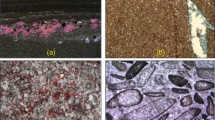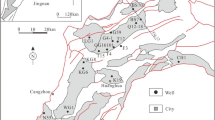Abstract
The deep-burial Ordovician carbonate reservoirs in the Yangshuiwu area (Jizhong Depression) have shown significant hydrocarbon potential since 2016. In this paper, based on the systematic investigation of characteristics and diagenesis of the reservoirs using cores, thin sections, logging, drilling, and geochemical analysis, their controlling factors and formation mechanism were discussed. The three high-quality reservoir belts (RBs) developed in the Ordovician strata are named RB1 (karst reservoirs), RB2 and RB3 (dolostone reservoirs) from top to bottom, each with its own set of pores, vugs, caves, and fractures. The results show that dolostones have relatively higher porosity and permeability than limestones and breccias. Unfilled and partly filled fractures, in particular, multiply enhance reservoir permeability. Additionally, the diagenetic paragenesis developed in marine, meteoric, and burial environments leads to the porosity evolution of Ordovician carbonates, mainly including compaction, calcite cementation, dolomitization, dissolution, and fracturing. Notably, sedimentation and dolomitization controlled by sea-level fluctuations are critical for the reservoirs formation. The tidal-flat sequence of each cycle of sea-level fluctuations influences their distribution. Subaerial meteoric water dissolution triggered by the Late Ordovician uplift plays an important role in the RB1, but has a negligible effect on the RB2 and RB3. Most importantly, the conductive high-angle fractures induced by the activities of the Yangshuiwu and Hexiwu faults from the Eocene to Pliocene can enhance all RBs potential, contributing to the ultimate reservoir quality. Therefore, a four-stage theoretical development model of the Ordovician reservoirs was established in combination with the tectonic background.

















Similar content being viewed by others
References
James, N.P.; Choquette, P.W.: Diagenesis 9. limestones - the meteoric diagenetic environment. Geosci. Canada. 11, 161–194 (1984)
Tucker, M.E.; Wright, V.P.: Carbonate Sedimentology, p. 34–38. John Wiley & Sons, Hoboken (2009)
Ehrenberg, S.N.; Nadeau, P.H.: Sandstone vs. carbonate petroleum reservoirs: A global perspective on porosity-depth and porosity-permeability relationships. Am. Ass. Petrol. Geol. Bull. 89, 435–445 (2005). https://doi.org/10.1306/11230404071
Lucia, F.J.: Carbonate Reservoir Characterization, 2nd edn. Springer, Austin, Texas (2007)
Ahr, W.M.: Geology of Carbonate Reservoirs: The Identification, Description, and Characterization of Hydrocarbon Reservoirs in Carbonate Rocks. John Wiley & Sons, Hoboken (2008)
Ronchi, P.P.; Ortenzi, A.; Borromeo, O.; Claps, M.; Zempolich, W.G.: Depositional setting and diagenetic processes and their impact on the reservoir quality in the late Visean-Bashkirian Kashagan carbonate platform (Pre-Caspian Basin, Kazakhstan). AAPG Bulletin. 94, 1313–1348 (2010). https://doi.org/10.1306/01051009130
Moore, C.H.; Wade, W.J.: Chapter 9-Summary of early diagenesis and porosity modification of carbonate reservoirs in a sequence stratigraphic and climatic framework. Developments in Sedimentology, p. 207–238. Elsevier, Hoboken (2013)
Amel, H.; Jafarian, A.; Husinec, A.; Koeshidayatullah, A.; Swennen, R.: Microfacies, depositional environment and diagenetic evolution controls on the reservoir quality of the Permian Upper Dalan Formation, Kish Gas Field. Zagros Basin. Marine and Petrol. Geol. 67, 57–71 (2015). https://doi.org/10.1016/j.marpetgeo.2015.04.012
Cantrell, D.L.; Shah, R.A.; Ou, J.; Xu, C.; Phillips, C.; Li, X.L.; Hu, T.M.: Depositional and diagenetic controls on reservoir quality: Example from the upper Cretaceous Mishrif Formation of Iraq. Marine Petrol. Geol. (2020). https://doi.org/10.1016/j.marpetgeo.2020.104415
Fu, Q.; Hu, S.; Xu, Z.; Zhao, W.; Shi, S.; Zeng, H.: Depositional and diagenetic controls on deeply buried cambrian carbonate reservoirs: longwangmiao formation in the Moxi-Gaoshiti area, Sichuan Basin, southwestern China. Marine Petrol. Geol. (2020). https://doi.org/10.1016/j.marpetgeo.2020.104318
Choquette, P.W.; Pray, L.C.: Geologic nomenclature and classification of porosity in sedimentary carbonates. Am. Asso. Petrol. Geol. Bull. 54, 161–194 (1970). https://doi.org/10.1306/5d25c98b-16c1-11d7-8645000102c1865d
Li, Yang; Kang, Zhijiang; Xue, Zhaojie; Zheng, Songqing: Theories and practices of carbonate reservoirs development in China. Petrol. Explor. Develop. 45(4), 712–722 (2018). https://doi.org/10.1016/S1876-3804(18)30074-0
Ma, Yongsheng; Cai, Xunyu; Zhao, Peirong; Zhang, Xuefeng: Formation mechanism of deep-buried carbonate reservoir and its model of three-element controlling reservoir: a case study from the Puguang oilfield in Sichuan. Acta Geologica Sinica. 84(8), 1087–1094 (2010)
Ma, Yongsheng; Cai, Xunyu; Zhao, Peirong: The research status and advances in porosity evolution and diagenesis of deep carbonate reservoir. Earth Sci. Front. 18(4), 181–192 (2011)
Ma, Yongsheng; He, Zhiliang; Zhao, Peirong; Zhu, Hongquan; Han, Jun; You, Donghua; Zhang, Juntao: A new progress in formation mechanism of deep and ultra-deep carbonate reservoir. Acta Petrolei Sinica. 40(12), 1415–1425 (2019)
Chen, A.; Xu, S.; Yang, S.; Chen, H.; Su, Z.; Zhong, Y.; Hu, S.: Ordovician deep dolomite reservoirs in the intracratonic ordos Basin, China: depositional model and diagenetic evolution. Energy Explor. Exploit. 36, 1–14 (2018). https://doi.org/10.1177/0144598718778171
Zhu, D.; Meng, Q.; Jin, Z.; Liu, Q.; Hu, W.: Formation mechanism of deep cambrian dolomite reservoirs in the Tarim basin, northwestern China. Mar. Pet. Geol. 59, 232–244 (2015). https://doi.org/10.1016/j.marpetgeo.2014.08.022
He, Zhiliang; Zhang, Juntao; Ding, Qian; You, Donghua; Peng, Shoutao; Zhu, Dongya; Qian, Yixiong: Factors controlling the formation of high-quality deep to ultra-deep carbonate reservoirs. Oil and Gas Geology. 38, 633–763 (2017)
Zhao, X.; Jin, F.; Wang, Q.; Bai, G.: Buried-hill play, Jizhong subbasin, Bohai Bay basin: A review and future perspectivity. AAPG Bull. 99(1), 1–26 (2015). https://doi.org/10.1306/07171413176
Du, Jinhu; He, Haiqing; Zhao, Xianzheng; Zhang, Yiming; Wang, Quan; Zhang, Ruifeng; Hou, Fengxiang; Han, Chunyuan; Fan, Bingda: Significant exploration breakthrough in Yangshuiwu ultra-deep and ultra-high temperature Ordovician buried hill in Langgu sag. Bohai Bay Basin. China Petrol. Explor. 22(2), 1–13 (2017). https://doi.org/10.3969/j.issn.1672-7703.2017.02.001
Zhang, Yiming; Jianzhang, Tian; Dexiang, Yang; Shuguang, Chen; Xing, Liu; Fengxiang, Hou; Ran, Tian; Chuanbao, Zhang: Great breakthroughs and key technologies in exploration of Ordovician deep buried hill in northern Jizhong depression. Int. Petrol. Technol. Conf. OnePetro (2019). https://doi.org/10.2523/IPTC-19279-MS
Feng, Zengzhao; Chen, Jixin; Wu, Shenghe: Early Paleozoic lithofacies and paleogeography of the north China platform. Acta Sedimentol. Sin. 7(4), 15–55 (1989)
Chen, R.K.; Meng, X.H.: Early Paleozoic sedimentary suites and the evolution of the north China platform. J. Palaeogeogr. 13(4), 46–55 (1993)
Xiang, P.F.; Ji, H.C.; Shi, Y.Q.; Huang, Y.; Sun, Y.S.; Xu, X.R.; Zou, S.Q.: Petrographic, rare-earth elements and isotope constraints on the dolomite origin of Ordovician Majiagou Formation (Jizhong Depression North China). Marine Petrol. Geol (2020). https://doi.org/10.1016/j.marpetgeo.2020.104374
Chen, X.; Xu, H.: The origin and occurrence of ordovician carbonate rock reservoir of North China platform. Acta Sedimentol. Sin. 12(03), 47–55 (1994)
Yu, H.Z.; Lu, Fuliang; Guo, Qingxin; Lü, Wenzhong; Wu, Jinyun; Han, Shouhua: Proto-sediment basin types and tectonic evolution in the southern edge of North China Plate. Petrol. Geol. Experiment. 27(02), 111–11 (2005)
Jiu, B.; Huang, W.; Mu, N.; Li, Y.: Types and controlling factors of Ordovician paleokarst carbonate reservoirs in the southeastern Ordos Basin China. J. Petrol. Sci. Eng. (2021). https://doi.org/10.1016/j.petrol.2020.108162
Meng, X.; Ge, M.; Tucker, M.E.: Sequence stratigraphy, sea-level changes and depositional systems in the Cambro-Ordovician of the North China carbonate platform. Sediment. Geol. 114(1–4), 189–222 (1997). https://doi.org/10.1016/S0037-0738(97)00073-0
Li, Yubang; Zhang, Yiming; Yang, Dexiang; Gao, Da.; Huang, Yun; Gao, Lanzhu; Tian, Jianzhang; Wang, Shuai: Lithofacies paleogeography of the Ordovician in Jizhong depression. J. Palaeogeography (Chinese Edition). 23(2), 359–374 (2021)
Dickson, J.A.D.: Carbonate identification and genesis as revealed by staining. SEPM J. Sedim. Res. 36, 491–505 (1966). https://doi.org/10.1306/74d714f6-2b21-11d7-8648000102c1865d
Liu, G.S.: Tectonic Evolution and Hydrocarbon Accumulation in Yang Shuiwu Buried Hill Belt Western Bohai Bay Basin. China University of Geosciences (Beijing), China (2020)
Taylor, H.P.: The application of oxygen and hydrogen isotope studies to problems of hydrothermal alteration and ore deposition. Econ. Geol. 69(6), 843–883 (1974). https://doi.org/10.2113/gsecongeo.69.6.843
Anderson, T.F.; Arthur, M.A.: Stable isotopes of oxygen and carbon and their application to sedimentologic and paleoenvironmental problems. Stable Isotopes Sedim. Geol. 10, 1–151 (1983). https://doi.org/10.2110/scn.83.01.0000
Scholle, P.A.; Ulmer-Scholle, D.S.: A color guide to the petrography of carbonate rocks: grains, textures, porosity, diagenesis. AAPG Mem. 77, 331–370 (2003)
Lan, Yefang; Huang, Sijing; Huang, Keke; Zhou, Xiaokang; Wei, Zhe: Cathodoluminescence features and diagenetic stage division of carbonates in the Zhujiang Formation, Pearl River Mouth Basin. Petrol. Geol. Recovery Eff. 24(01), 34–42 (2017)
Evamy, B.D.: Dedolomitization and the development of rhombohedral pores in limestones. SEPM J. Sedim. Res. 37(4), 1204–1215 (1967). https://doi.org/10.1306/74d71870-2b21-11d7-8648000102c1865d
Mao, Liguang; Yang, Dexiang; Li, Xiaoheng; Zhang, Chuanbao; Tian, Jianzhang; Wang, Xin; Ming, Jin; Xiao, Ancheng: Characteristics and controlling factors of the Paleogene magmatic activities in the northern Jizhong Depression. Chinese J. Geol. 55(2), 506–518 (2020)
Schlager, W.: The paradox of drowned reefs and carbonate platforms. Geol. Soc. Am. Bull. 92(4), 197–211 (1981)
Bice, D.: Synthetic stratigraphy of carbonate platform and basin systems. Geology 16(8), 703–706 (1988)
Spencer, R.J.; Demicco, R.V.: Computer models of carbonate platform cycles driven by subsidence and eustasy. Geology 17(2), 165–168 (1989)
Carcel, D.; Colombié, C.; Giraud, F.; Courtinat, B.: Tectonic and eustatic control on a mixed siliciclastic-carbonate platform during the Late Oxfordian-Kimmeridgian (La Rochelle platform, western France). Sed. Geol. 223(3–4), 334–359 (2010). https://doi.org/10.1016/j.sedgeo.2009.11.018
Ross, C.A.; Ross, J.R.: Sea-level changes: an integrated approach. Sea-level changes: an Integrated Approach. 14(6), 535–535 (1986). https://doi.org/10.1130/0091-7613(1986)14%3c535:scaia%3e2.0.co;2
Liu, J.B.; Zheng, Z.C.: Stacking patterns and correlation of meter-scale shallowing-upward cycles in the lower Ordovician carbonates in Pingquan and Qinglongshan, North China. J. Geol. Soc. Japan. 104(5), 327–345 (1998). https://doi.org/10.5575/geosoc.104.327
Longman, M.W.: Carbonate diagenetic textures from nearsurface diagenetic environments. AAPG Bull. 64(4), 461–487 (1980)
Mazzullo, S.J.: Overview of porosity evolution in carbonate reservoirs. Kansas Geol. Soc. Bulletin. 79(1–2), 1–19 (2004)
He, Zhiliang; Zhang, Juntao; Ding, Qian; You, Donghua; Peng, Shoutao; Zhu, Dongya; Qian, Yixiong: Factors controlling the formation of high-quality deep to ultra-deep carbonate reservoirs. Oil and Gas Geol. 38(4), 633–763 (2017)
Zhang, Shanwen., Qiao, Dewu., Sui, Fenggui., Lv, Xixue., Lin, Huixi., Liu, Hua., Zhang, Shoupeng., Li, Juyuan., Peng, Chuansheng., Wang, Yulin., Qiu, Haijun., Li, Zheng., Hao, Yunqing., Bian, Xuemei., Liu, Gang.: Strategic Investigation and Evaluation of Pre-Paleogene Oil and Gas Resources in North China. Geology Press (2014)
Li, Z.M.: Pathway System and Hydrocarbon Migration and Accumulation of Hexiwu Buried-hill Zone in Jizhong Depression. China University of Petroleum (Beijing), China (2020)
Wang, Z.; Zhou, H.; Wang, X.; Zheng, M.; Santosh, M.; Jing, X.; Zhang, J.; Zhang, Y.: Detrital zircon fingerprints link western North China Craton with east Gondwana during Ordovician. Gondwana Res. 40, 58–76 (2016). https://doi.org/10.1016/j.gr.2016.08.007
Acknowledgements
This study was supported by the National Key Research & Development Program of China (Grant Numbers 2019YFB1504101 and 2018YFC0604301), the CNPC Science & Technology Major Project (Grant Number 2017E-15), and the China Scholarship Council (CSC). We specially thank Dr. Bassam El Ali and anonymous reviewers for their constructive comments and suggestions to improve the manuscript. We also acknowledge the experts of PetroChina Huabei Oilfield Company for their help.
Author information
Authors and Affiliations
Corresponding authors
Ethics declarations
Conflict of interest
The authors declare that they have no confict of interest.
Supplementary Information
Below is the link to the electronic supplementary material.
Rights and permissions
About this article
Cite this article
Xiang, P., Ji, H., Shi, Y. et al. Characteristics, Diagenesis, Controlling Factors and Formation Mechanism of Deep-Burial Ordovician Carbonate Reservoirs in the Yangshuiwu Area, Jizhong Depression, Bohai Bay Basin. Arab J Sci Eng 48, 645–663 (2023). https://doi.org/10.1007/s13369-022-07050-7
Received:
Accepted:
Published:
Issue Date:
DOI: https://doi.org/10.1007/s13369-022-07050-7




